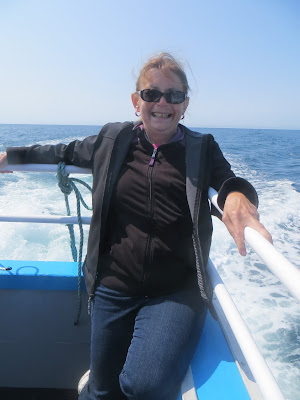The works impose themselves on me - I am their slave."
The tragic story of Daedalus and Icarus inspired Mitoraj,
and the exhibit contained a number of magnificent sculptures
based on the two:
Daedalus, the skilled craftsman and artist who created
the labyrinth for King Minos of Crete,
and his son Icarus who flew too close to the sun with wax wings
and plunged to the earth when they melted.
King Minos had imprisoned father and son in the labyrinth,
and Daedalus and Icarus tried to escape with wings crafted by Daedalus.
Icarus drowned in the Mediterranean while his father watched from above.
Mitoraj built on the legend by imagining a sister Ikaria for Ikaro (Icarus).
The Death of Icarus
Regio VIII, Ancient Pompeii, Italy
Daedalus and Icarus fresco, villa imperiale, Pompeii
To me there was a wonderful synergy in the connection
between ancient Pompeii and Igor Mitoraj's art.
After the exhibit ended, the Mitoraj Foundation and the Contini Art Gallery
gave Italy a gift of Mitoraj's Daedalus, one of his sculptures displayed in Pompeii.
It will remain at the entrance to Pompeii near the Temple of Venus.
Daedalus
by Igor Mitoraj
At the Entrance to Pompeii near the Temple of Venus
Regio VIII, Ancient Pompeii, Italy
May 20, 2016
© M. Louise (MacBeath) Barbour/Fundy Blue
Daedalus
by Igor Mitoraj
Overlooking the Sorrento Peninsula from the Temple of Venus
Regio VIII, Ancient Pompeii, Italy
May 20, 2016
© M. Louise (MacBeath) Barbour/Fundy Blue
It was Mitoraj's dream to have his sculptures displayed in Pompeii.
He selected the exact location for each sculpture chosen for the temporary exhibit.
Sadly, he died in Paris on October 6, 2014 and never saw his sculptures
in situ among the excavations of ancient Pompeii.
This extraordinary exhibit was designed and promoted
by the foundation Terzo Pilastro ~ Italia e Mediterraneo,
with the support of the Ministry of Cultural Heritage and Activities and Tourism.
It was organized by Pompeii's Superintendency, the Contini Art Gallery,
and the Atelier Igor Mitoraj Contemporary Art Museum in Pietrasanta.
Centauro or Centaur
by Igor Mitoraj
Forum, Regio VII, Ancient Pompeii, Italy
May 20, 2016
© M. Louise (MacBeath) Barbour/Fundy Blue
Pompeiani III (2007)
by Igor Mitoraj
Bronze and Marble: 176 cm. X 75 cm. X 75.5 cm.
Terme Stabiane or Stabian Baths
Regio VII, Ancient Pompeii, Italy
May 20, 2016
© M. Louise (MacBeath) Barbour/Fundy Blue
All Rights Reserved
One of the Few Female Sculptures at the Pompeii Exhibit
by Igor Mitoraj
Terme Stabiane or Stabian Baths
Regio VII, Ancient Pompeii, Italy
May 20, 2016
© M. Louise (MacBeath) Barbour/Fundy Blue
Grande Toscano (1981)
by Igor Mitoraj
Bronze: 272 cm. X 185 cm. X 80 cm.
Forum, Regio VII, Ancient Pompeii, Italy
May 20, 2016
© M. Louise (MacBeath) Barbour/Fundy Blue
All Rights Reserved
The temporary Mitoraj exhibit in Pompeii may be long over,
but I will always remember how exquisite these sculptures were.
To think I knew nothing about it, when I first walked into Pompeii.
Sometimes you just get lucky!
Memorie (2012)
by Igor Mitoraj
Forum, Regio VII, Ancient Pompeii, Italy
May 20, 2016
© M. Louise (MacBeath) Barbour/Fundy Blue










































